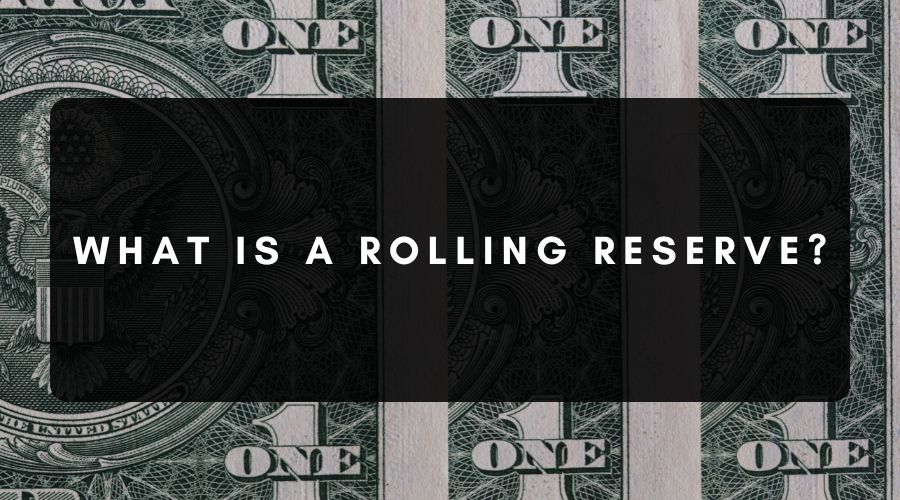
What Is a Rolling Reserve?
If you establish a new merchant account, you may be asked to set aside part of your gross sales in a rolling reserve. This is a type of non-interest-bearing cash reserve in which funds are held for a short period of time as a protective measure for both the merchant and merchant services provider.
What Is a Rolling Reserve & How Does It Work?
A rolling reserve is a fund in which a set percentage of each of the merchant’s debit and credit card transactions is held by the acquiring bank for a pre-specified period of time. The reserve funds are used to settle things like refunds and chargebacks and exist as protection for the merchant account provider in case the merchant becomes insolvent or refuses to cover these costs.
In a typical scenario, a percentage of credit card revenue is stored in the reserve upon the completion of each sale. Then, at the end of the waiting period, the funds are released into the merchant’s business bank account. This happens progressively, hence being called a “rolling” reserve. For example, if a merchant has $50 withheld on Day 1 and $60 withheld on Day 2 and has a waiting period of 30 days, $50 will be released on Day 31, $60 on Day 32, and so on.
For How Long Are Funds Kept in a Rolling Reserve?
The applicable percentage of the merchant’s gross revenue is stored in the rolling reserve for a predetermined period, usually one to two weeks. Some rolling reserves can last much longer. For example, up to 90 or even 180 days.
The payout schedule can be daily or monthly. With a daily payout schedule, the withheld amounts are released from the rolling reserve account after exactly the pre-specified number of days. With a monthly payout schedule, all of the funds withheld during a certain month are released after the number of months specified in the contract, at the end of the month.
What Percentage Is Held in a Rolling Reserve?
Merchant account providers set their own percentages for each rolling reserve merchant account. The percentage may also vary depending on your processing volume. Typically, traditional merchant account providers withhold around 5-10% of each transaction. However, merchants who have been placed on the MATCH list may be subjected to percentages up to 100%.
If your merchant provider requires a rolling reserve, you will be notified of the exact terms when you apply for an account. You will then have the chance to negotiate the terms or have the terms reviewed by your lawyer (if you have legal representation) before signing on the dotted line.
When Might a Merchant Need a Rolling Reserve?
Some merchant service providers require a rolling reserve for all merchants. Other providers weigh the need on a case-by-case basis. Your account may be selected for a rolling reserve if:
- Your business credit history is less than perfect (see our article on how to get a merchant account with bad credit).
- Your industry has a higher-than-average likelihood of fraud and/or credit card chargebacks.
- Your merchant account has been subject to an above-average number of customer complaints or disputes.
- Your business processes a large number of pre-orders for products that are not yet available.
- Your business is new and you don’t yet have any credit card processing history upon which to assess your risk level.
Make sure to speak with your merchant services provider if you are unsure of the requirements for your business.
Pros and Cons of a Rolling Reserve for Merchants
A rolling reserve might seem like a pure inconvenience. After all, you would prefer to receive all of your revenue straight away. However, rolling reserve accounts offer several potential benefits as well as the obvious drawbacks.
Pros
- For some merchants, accepting a rolling reserve requirement might be the only way to qualify for payment processing services—especially if they have been placed on the MATCH list. Merchant acquirers can search the MATCH™ database when doing due diligence on a potential merchant and most are unlikely to grant listed merchants an account without the security of a significant rolling reserve.
- A rolling reserve provides a safety net for both you and the merchant services provider. It gives you the assurance that the funds are there in case you need to provide a refund or reverse a disputed charge.
- A rolling reserve can contribute to lower rates for you, the merchant. It can also give you access to a greater selection of merchant service providers.
- There is no loss to you as a merchant. While your funds will be subject to a slight delay, you will receive them eventually (minus any refunds and chargebacks).
Cons
- Rolling reserves makes a portion of your revenue inaccessible, which can create cash flow challenges—especially for new businesses. The upside is that the rolling reserve acts as a kind of forced savings account, which can help you get into good habits early on.
- Long waiting periods can be very frustrating for merchants.
Remember: A provider’s main goal is to mitigate risk. Some do this by being extremely choosy about the merchants they accept or by subjecting certain merchants to higher rates. Other merchant providers use rolling reserves as a way to offer service and premium rates to all merchants while still protecting their investment.
Other Kinds of Reserves
There are other kinds of reserves (besides rolling reserves) that payment processors might use:
Capped Reserves
With a capped reserve, a percentage of the funds are withheld from each transaction until a predetermined “cap” is reached. No further funds are withheld after this. However, the reserved amount remains inaccessible until the merchant account is closed.
Up-Front Reserves
Merchant account providers can ask for a lump sum payment at the beginning of the merchant’s contract to be held in reserve. This gives the payment processor security at the outset. The funds in the up-front reserve can then be released gradually over time as the merchant proves his or her trustworthiness.
Rolling Reserves Can Work in Your Favour
Rolling reserves might seem annoying or frustrating at the outset. However, they do come with several potential benefits. These benefits include access to a wider range of merchant accounts, potentially lower fees, protection in the case of unexpected chargeback costs, and—for some merchants—the ability to accept card payments at all.
When shopping around for a merchant services provider, the key is to always read the fine print and ask questions. You don’t want to be blindsided by a rolling reserve, but you also don’t want to disqualify a merchant provider simply because they impose one. As long as you run a reputable business, the rolling reserve can work in your favour.

